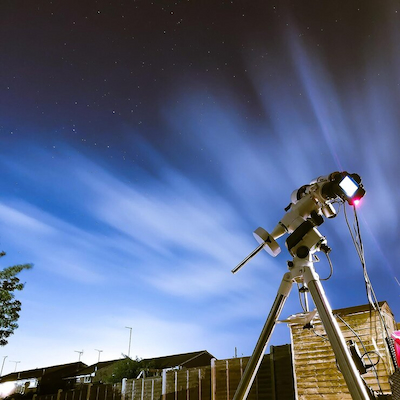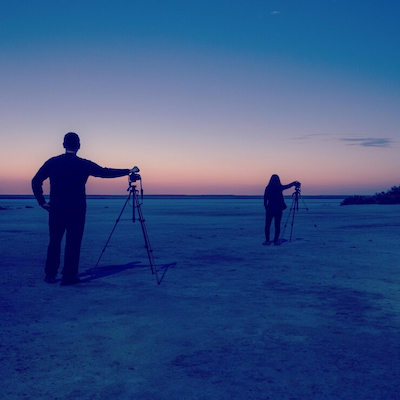
Astrophotography is one of the most fascinating branches of photography, allowing enthusiasts to capture breathtaking images of the cosmos. In recent years, an emerging technique called Live Stacking has gained attention, revolutionizing the way astronomical images are captured and processed. This innovative approach makes it easier to produce high-quality images while offering a near real-time experience for sky watchers and photographers.
Live Stacking allows astrophotographers to stack multiple exposures dynamically, significantly improving the quality of the final image. Unlike traditional techniques that require long exposure times and extensive post-processing, Live Stacking offers immediate visual feedback, making astrophotography more accessible and exciting. In this article, we’ll explore how this technique works, its advantages, and how enthusiasts can apply it in their astrophotography practice.
How Live Stacking Techniques Work in Astrophotography
Live Stacking involves capturing multiple exposures of a celestial object and stacking those images in real time. The process starts with setting up a telescope and camera, with the image projected into capture software that supports Live Stacking. As exposures are taken, the software analyzes each one, identifying and aligning shared features such as stars or nebula details.
Once aligned, the software combines the data into a single image with higher resolution and reduced noise. This stacking is performed in real time, allowing the photographer to see the result almost immediately. Live Stacking uses advanced algorithms to optimize image quality, automatically adjusting brightness and contrast to deliver a clearer and more detailed view of the target object.
Additionally, Live Stacking is highly efficient, making it possible to capture faint celestial objects that might otherwise be missed in a single long exposure. By stacking multiple short exposures, details invisible to the naked eye or a single frame can be revealed. This makes Live Stacking a powerful tool for exploring everything from planets to distant galaxies.
The flexibility of Live Stacking allows astrophotographers to make real-time adjustments to exposure time and the number of frames stacked. This means they can quickly respond to changing conditions such as cloud cover or fluctuations in sky brightness — a key factor in why Live Stacking appeals to photographers at all experience levels.

Advantages of Using Live Stacking: Near Real-Time Astrophotography
One of the main advantages of Live Stacking is the ability to see results almost instantly. Unlike traditional astrophotography, where photographers must wait long periods before viewing the final image, Live Stacking lets users see a developing image as new frames are captured. This makes the process more interactive and allows immediate adjustments to improve image quality.
Another major advantage is noise reduction. Stacking multiple exposures smooths out noise caused by factors like camera temperature or light pollution. As a result, images captured using Live Stacking tend to be cleaner and more detailed, helping astrophotographers capture subtle features that would be lost in a single frame.
Live Stacking is also very beginner-friendly. With modern software, many Live Stacking programs are intuitive and easy to use, making it possible for people with no prior astrophotography experience to get impressive results. This democratizes the hobby and encourages more people to explore the night sky.
Additionally, Live Stacking adapts well to varying observing conditions. Astrophotographers can quickly change exposure time and frame count, adjusting to different scenarios. Whether dealing with limited visibility or tracking a dim object, Live Stacking offers a flexible solution for capturing high-quality astronomical images.
How to Perform Live Stacking in Astrophotography
To perform Live Stacking effectively, follow these steps:
-
Choose the right equipment: You’ll need a telescope, a compatible camera, and a computer or tablet with Live Stacking software installed. Ensure everything is calibrated and aligned before starting.
-
Set up your software: Launch your chosen Live Stacking software, connect your camera, and configure capture preferences such as exposure time, gain, and the number of frames to stack.
-
Start capturing: Point your telescope at your desired celestial object and begin capturing frames. The software will start stacking exposures in real time, letting you watch the image build as you go.
-
Adjust settings as needed: During the session, adjust exposure settings or frame count depending on sky conditions or target brightness.
-
Finalize your image: Once satisfied, save the stacked image to your computer. Many programs also include basic editing tools for color, contrast, and sharpening.
-
Share your results: Finally, share your images with the astrophotography community! Online platforms and social media are great places to showcase your work and learn from others.
Live Stacking is an accessible and exciting technique that can transform how you capture images of the cosmos. By following these steps, you’ll be able to explore the night sky and produce stunning images in real time.

Did You Enjoy Learning About Live Stacking: Near Real-Time Astrophotography?
Learning about Live Stacking opens the door to a new dimension of astrophotography — one where technology and creativity meet under the night sky. This innovative technique not only makes it easier to capture stunning celestial images, but also transforms the entire observing experience into something immediate, immersive, and deeply rewarding.
With Live Stacking, you’re no longer limited to waiting hours to see the final result. Instead, you watch your image take shape in real time, seeing details emerge with every new exposure. This continuous feedback loop enhances learning, empowers quick adjustments, and allows even beginners to gain confidence and competence quickly. Each frame added is a step closer to revealing the hidden beauty of the universe — and you get to witness that transformation as it happens.
Live Stacking also invites a sense of play and experimentation. Want to adjust the exposure, change your subject, or refocus your alignment? You can do it on the spot and see the effect immediately. This flexibility fosters exploration and creativity, encouraging users to push their boundaries and discover what works best in different conditions.
Moreover, this technique encourages connection — not just with the sky, but with a global community of astrophotographers. As more people adopt Live Stacking, there’s a growing wealth of shared knowledge, tips, tutorials, and inspiration that make it even more approachable and enjoyable. Whether you’re imaging from a backyard observatory or a remote dark-sky site, you’re part of a collective journey to understand and celebrate the cosmos.
If this introduction to Live Stacking sparked your curiosity, don’t stop here. Try it yourself. Explore the tools, experiment with different targets, and let the sky surprise you. With Live Stacking, the stars aren’t just far away — they’re active collaborators in your creative process. The universe is out there, waiting. And now, you have a way to experience it like never before — one frame at a time.
Frequently Asked Questions
What is Live Stacking in astrophotography?
Live Stacking allows you to capture images of stars and galaxies while you observe them in near real time, producing a clearer final image as exposures are added.
How does Live Stacking work?
It combines multiple images rapidly. The software aligns and stacks the frames live, creating a detailed image you can watch improve as you go.
What equipment do I need for Live Stacking?
You’ll need a compatible camera, a telescope, and a computer running specialized Live Stacking software.
Is it easy to use Live Stacking?
Yes, it’s quite user-friendly! Most programs include tutorials and simplified interfaces to help you get started.
Can I use Live Stacking anywhere?
Yes, though darker locations with less light pollution are best. This greatly enhances the quality of your Live Stacking results.
Can Live Stacking be used with planetary imaging?
Yes! While often used for deep-sky objects, Live Stacking can also enhance planetary images by improving detail and reducing distortion from atmospheric turbulence.
Is Live Stacking suitable for urban stargazing?
Absolutely. Live Stacking helps reduce the impact of light pollution, making it ideal for observers in cities or suburban areas.
What software is recommended for Live Stacking?
Popular options include SharpCap, AstroToaster, and ASIStudio. Each has unique features depending on your camera and preferences.
Can I combine Live Stacking with traditional post-processing?
Yes. You can save your live-stacked image and continue editing it in programs like GIMP or Photoshop to enhance colors, contrast, and clarity even further.

